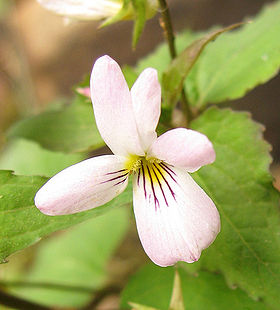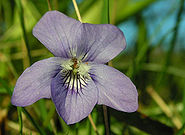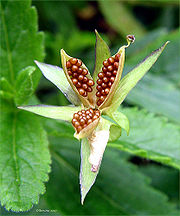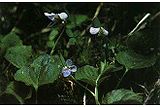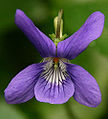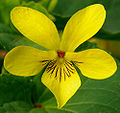Violet
| Violet |
|---|

|
| Scientific Classification |
|
| Species |
|
Contains 125 Species: |
| closed up picture of Canada Violet |
Violets are any of the species of flowering plants that belong to the taxonomic Genus Viola. Violets are medium sized dispersed shrubs or herbs.(Pojar and MacKinnon, p200) that are native to the Northern Hemisphere, but have spread to the Australasia, Andes, and Hawaii. Since violets can grow anywhere that has good conditions for violets, they can be found everywhere. The conditions that they prefer to live in are moist and dark areas. Also temperature of that area cannot be too high. The reason is that violets actually live under the sun. It is better to live without sun. Also many of violets are found between rocks.[1] Violets are perennial plants which means that they live for several years. People might think that violets are biennials or annuals. [2] Their flowers that are bilaterally symmetric are showy with five sepals and five petals. They also have five stamens and one ovary that is superior. (Pojar and MacKinnon, p200) Because of violets' characteristics that they usually grow in shade areas, violets became a problem because they spread too much into many different areas. However, fortunately, there are several controls to solve this problem.[3]
Anatomy
Most violets are small. However, not every single one is the same. This really depends on the kinds of violets. For example, Viola adunca, sand violet, can reach to 4cm. [4]Most violets are herbaceous and some of them do not have obvious stems. Their flowers and leaves seem to grow from the ground. Violets usually have five sepals at the base and have five petals. Petals are the lower and the larger than others and they have a spur. Also honey is secreted from the petals by the spurs. [5] Petals of violets can exist as solitary or in pairs. To summarize the structure of the violets, they have five petals. The lower one is larger than others. They also have five stamens and one ovary that is superior. (Pojar and MacKinnon, p200) Four of them are curved or two per side with fan- shaped petals. There is also one petal with lobed and broad that is pointing downward . The shapes of petals can vary depending on species, and people can distinguish their species by looking at the petals.[6]Commonly, the shape of Violets leaves are heart- shaped, and they are asymmetrical flowers.[7] Five anthers usually hold the pollens on very short stems.[8] Anthers are worthy of attention for the processes of color. Anthers form like cone- shaped things around the style. [9]
The chasmogamous flowers are the showy flowers which attract people.[10] After larger flowers perish, some people take the violets look very carefully and closely, and will be able to see the cleistogamous flowers. These are the flowers that self- pollinate to make violet seeds. [11]Each different violet specie has different color. However, most violets have blue, white, pink, or deep purple.[12] The ovary, which is one celled, has three placentas and many ovules. It makes a single style which ends with a opened stigma. In order to get the honey which is in the spur of the flower, insects have to push through violets' proboscis. Proboscis is located in the part of anterior with a edged groove with hairs on the lower part of petal. [13] Scent of violet is very difficult to find. The male violet contains five stamens and anthers.[14] The main component of violet's scent is ionone which is a ketone compound. This make the receptors in the nose less sensitive for the moment. [15] When the violets are first cut, the scent is very strong. However, the scent disappears rapidly. More than 2 million flowers are needed to make a pound of the essential oil.[16]
Reproduction
There are several ways that violets can be reproduced. Violets can be reproduced by rhizomes which are stems that creep underground. Also, violets can be reproduce by runners without seeds. The runners and rhizomes also make two different kinds of flowers. They both produce seeds. The chasmogamous flowers, which are very beautiful and usually bloom in May, make seeds and scatter them four feet away. The cleistogamous flowers, which are small blooms that are at the bottom of the plant, make plenty of seeds too.[17] There is a hidden fertilizer which is called cleistogamous. In the spring, the purple flowers appear. They are fully- formed and people can smell the scent. They are hidden by the leaves, and they look like they are not important. However, inside of that flowers, is full of seeds.[18] After the violets flower, fruit capsules are made within three valves. Also three valves are opened, so people can see the seeds. Seeds of violets can be spread by insects such as ants, or nature. Cleistogamous flowers are produced as self- pollinated flowers in summer. [19]
The means of reproduction can be varied by species. For example, the Sweet Violet can be reproduced by spreading seeds. Formica polyctena ants usually carry the seeds of Sweet Violet. This is why Sweet Violets are found in many kinds of regions. Since Sweet Violet has big sized seeds, they expect Formica Polyctena ants to spread them. Sweet Violets also use double fertilization to reproduce themselves. Double fertilization means that when a plant's sperm nucleus sticks with the nucleus of eggs to make an embryo, and the nucleus of the other sperm's nucleus sticks with polar nuclei to create an endosperm. [20]
Ecology
The temperate Northern Hemisphere is violet's native. Violets are also dispersed in Australasia, the Andes in South America, and Hawaii. They are usually found in wet and dark conditions.[21] This means that Violets can raise best in wet, moist, cool, and covered areas. However, they can also survive in dried and sunny places too. Since violets prefer to live in moist areas, they really do not need sunlight. Violets can also be found between rocks. [22][23] Since violets grow best in moist areas, they get dried during the summer. If soil is also very moist but not too wet, it is the best environment for them to grow well. [24] Violets can grow in winter if the minimum winter temperature is 10 to 20 degrees Fahrenheit. This applies to the southern United States. If the violets were planted in fall, they can live through all the freezing weather and snowfalls well.[25] Violets are actually perennial plants. However, sometimes people think that they are biennials or annuals because they survive in freezing weather and they die in hot summers.[26]
There are also many ways that violets can obtain their nutrients. For instance, the Sweet Violets can make their own foods. This is called an autotroph. Also the Sweet Violet can gain water and food with several ways. The xylem cells help the water be transported to the Sweet Violet from the ground. The xylem cells carry the water to the spot where evaporation and photosynthesis occur. The Sweet Violet have pore openings called stomata on their leaves. The stomata helps to open and close for gas exchanging and water loss. Then that water will be pulled up through the xylem cells. After water arrives at the top of the Sweet Violets, it moves to the phloem to carry the nutrients that are made by the photosynthesis toward the whole part of the Sweet Violet.[27]
Medicinal Use
Violets can be used in different ways. Since violets are edible, they can be used for medications. Also, violets can be used as lotions, or perfumes or other scent. For medication use, flowers, roots, and leaves are going to be used.
Nervousness and Brain
- Insomnia
- Better memory
- Hysterical condition
Inflammatory problem
- Feel better from inflammation
- Pain in the joints or muscle
Liver Conditions
- Bitter liver problem
Respiratory Conditions
- Colds
- Coughs
As a mouthwash or gargle
- Gums
- Sore throats
Poultice
- Pimples
- Rheumatism
- Skin problems
- Tumors
- Cancerous growths
Lotion
- Skin disorder
- Eczema
Aromatherapy
- Violet's scent helps headache that is caused by not enough sleep[28]
Problems and controls
Violets prefer to live in shady and dark areas. Because of this characteristics, violets became problems. People can find the violets in most of shaded and dark areas. Violet is the one of the flowers that is very hard to control. Violets are very drought tolerant. Rhizomes which are underground stems, save the water and help the violets to survive in dried areas. The rhizomes also help the violets to disperse and form colonies. This perennial root systems help violets to be the hardest plants to get rid of. [29] In order to get rid of violets, people need to try many different methods. Also it takes more than one year to get rid of them completely.[30]
One of the control options is that people have to dig out all the violets that are existing in the ground. People have to make sure that they have to take all the roots and stems out. People can spray herbicides into violets. This is one of the best solutions. Also people can spray chlorsulfuron onto the violets. This has been used for other plants. However, people also can use this for getting rid of violets.[31] People should target violets to control in fall. Herbicides work best during the fall. If people try to get rid of violets during the summer, it is the worst thing to do. [32] Also there is another way to get rid of violets. Which is put the violets' roots on the ground and let the roots to be baked in the sun for several days. If this does not work, Mulching is one of the good ways to remove the bunch of violets.[33]
Gallery
Golden Violet
(Viola pedunculata)
Dog Violet
(Viola canina)
Johnny jumpup
(Viola tricolor)
Pioneer Violet
(Viola glabella)
Video
A video of Sweet Violets
 Browse |
References
- Classification for Kingdom Plantae Down to Genus Viola by the U.S. Department of Agriculture
- habitat of Violets The flower expert
- Characteristics of Violets You grow girl by Gayla Sanders
- Reproduction of violets Back yard gardner by Mike June 19th 2002
- Anatomy of Violets Wikipedia
- Reproduction of Violetsl Online Encyclopedia
- Reproduction of violets ardening- guides.com
- Environment and reproduction of violets Tools for natural living by Karyn Siegel-Maier
- Reproduction and general information Feeding the Muse
- Reproduction of violets Frugalista gardener
- Reproduction of Sweet violets Viola odorata by Katie Tacke
- General information and habitat Ehow by Phyllis Benson
- habitat of violets Umass Extension by Randall G. Prostak
- How to grow violets Gardeners' networks
- Environment of violets Essortment
- other uses of violets Global Herbal Supplies
- Problems and Controls of violets eHow by Analana
- Problems and Controls Landscape- America
- Problems and Controls Garden Guides.com By Barbara Fahs, Garden Guides Contributor
- Video of Sweet Violets Youtube.com by Szabolcs35
- PLANTS of the PACIFIC NORTHWEST COAST by Jim Pojar and Andy MacKinnon
